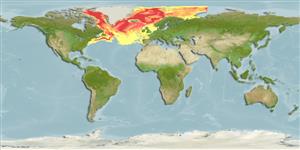Common names from other countries
Classification / Names / Names
প্রচলিত নাম সমূহ | প্রতিনাম সমূহ | Catalog of Fishes (gen., sp.) | ITIS | CoL | WoRMS
Environment: milieu / climate zone / depth range / distribution range
বাস্তুসংস্থান
; গভীরতার পরিসীমা 5 - 4500 m (Ref. 119523). Polar
Antarctic, Northeast Atlantic and the Arctic: Greenland, Kerguelen, Svalbard and the Canadian Arctic Archipelago.
Length at first maturity / আকৃতি / ওজন / Age
Maturity: Lm ? range ? - ? cm
Life cycle and mating behavior
পরিপক্কতা | প্রজনন | ডিম ছাড়া | ডিমসমূহ | ডিম্বধারন ক্ষমতা | শুককীট
Members of the class Ophiuroidea are mostly gonochoric, others are protandric. Fertilization is external. Brooding is common, bursae is used as brood chambers where the embryos develop into juveniles and later crawl out from the bursal slits. Life cycle: Embryos hatch into free-swimming planktotrophic larvae and later metamorphose into tiny brittle stars which sink down the bottom where they grow into adult form.
Piepenburg, D., N.V. Chernova, C.F. von Dorrien, J. Gutt, A.V. Neyelov, E. Rachor, L. Saldanha and M.K. Schmid. 1996. (Ref. 2952)
IUCN Red List Status (Ref. 130435)
CITES status (Ref. 108899)
Not Evaluated
Not Evaluated
Human uses
| FishSource |
হাতিয়ার
আরো তথ্য
প্রচলিত নাম সমূহপ্রতিনাম সমূহশিকারী প্রাণী সমূহপ্রজনন পরিপক্কতা ডিম ছাড়া ডিম্বধারন ক্ষমতা ডিমসমূহEgg development
Age/Size
বৃদ্ধি
Length-weight
Length-length
বহিঃ অঙ্গ সংস্থান
শুককীট
প্রাচুর্য
ইন্টারনেট সুত্র
Estimates based on models
Price category
Unknown.
